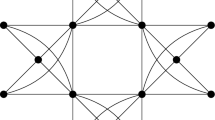Abstract
This paper solves the problem of increasing the edge-connectivity of a bipartite digraph by adding the smallest number of new edges that preserve bipartiteness. A natural application arises when we wish to reinforce a 2-dimensional square grid framework with cables. We actually solve the more general problem of covering a crossing family of sets with the smallest number of directed edges, where each new edge must join the blocks of a given bipartition of the elements. The smallest number of new edges is given by a min-max formula that has six infinite families of exceptional cases. We discuss a problem on network flows whose solution has a similar formula with three infinite families of exceptional cases. We also discuss a problem on arborescences whose solution has five infinite families of exceptions. We give an algorithm that increases the edge-connectivity of a bipartite digraph in the same time as the best-known algorithm for the problem without the bipartite constraint: O(km log n) for unweighted digraphs and O(nm log (n 2/m)) for weighted digraphs, where n, m and k are the number of vertices and edges of the given graph and the target connectivity, respectively.
Similar content being viewed by others
References
R.K. Ahuja, T.L. Magnanti, and J.B. Orlin, Network Flows: Theory, Algorithms and Applications, Prentice Hall: Englewood Cliffs, NJ, 1993.
J.A. Baglivo and J.E. Graver, Incidence and Symmetry in Design and Architecture, Cambridge University Press: Cambridge, 1983.
J. Bang-Jensen, H.N. Gabow, T. Jordán, and Z. Szigeti, “Edge-connectivity augmentation with partition constraints,” SIAM J. Disc. Math., vol. 12, no. 2, pp. 160–207, 1999.
J. Edmonds, “Edge-disjoint branchings,” in Combinatorial Algorithms, R. Rustin (Ed.), Algorithmics Press: New York, 1972, pp. 91–96.
A. Frank, “Augmenting graphs to meet edge-connectivity requirements,” SIAM J. Disc. Math., vol. 5, no. 1, pp. 25–53, 1992.
H.N. Gabow, “Applications of a poset representation to edge connectivity and graph rigidity,” in Proc. 32nd Annual Symp. on Found. of Comp. Sci., 1991, pp. 812–821.
H.N. Gabow, “A matroid approach to finding edge connectivity and packing arborescences,” J. Comp. and System Sci., vol. 50, no. 2, pp. 259–273, 1995.
H.N. Gabow and T. Jordán, “How to make a square grid framework with cables rigid,” in Proc. 10th Annual ACMSIAM Symp. on Disc. Algorithms, 1999, pp. 356–365; also SIAM J. Computing, vol. 30, no. 2, pp. 649–680, 2000.
H.N. Gabow and T. Jordán, “Bipartition constrained edge-splitting in directed graphs,” in Proc. 1st Japanese-Hungarian Symp. on Discrete Math. and its Applications, Kyoto, 1999, pp. 225–232; also Discrete Applied Mathematics, to appear.
J. Hao and J.B. Orlin, “A faster algorithm for finding the minimum cut in a directed graph,” J. Algorithms, vol. 17, no. 3, pp. 424–446, 1994.
J.-C. Picard and M. Queyranne, “On the structure of all minimum cuts in a network and applications,” Math. Prog. Study, vol. 13, pp. 8–16, 1980.
A. Recski, Matroid Theory and its Applications in Electric Network Theory and in Statics, Akadémiai Kiadó, Budapest, 1989.
Author information
Authors and Affiliations
Rights and permissions
About this article
Cite this article
Gabow, H.N., Jordán, T. Incrementing Bipartite Digraph Edge-Connectivity. Journal of Combinatorial Optimization 4, 449–486 (2000). https://doi.org/10.1023/A:1009885511650
Issue Date:
DOI: https://doi.org/10.1023/A:1009885511650




